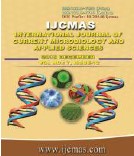


 National Academy of Agricultural Sciences (NAAS)
National Academy of Agricultural Sciences (NAAS)

|
PRINT ISSN : 2319-7692
Online ISSN : 2319-7706 Issues : 12 per year Publisher : Excellent Publishers Email : editorijcmas@gmail.com / submit@ijcmas.com Editor-in-chief: Dr.M.Prakash Index Copernicus ICV 2018: 95.39 NAAS RATING 2020: 5.38 |
Chickpea is a major pulse crop being grown for rich source of protein and form an important part of vegetarian diet and the crop being affected by various diseases; the wilt caused by Fusarium oxysporum f. sp. ciceri is a important disease occurs in many parts of the country and the pathogen in association with other soil-borne pathogens like root rots and stem rot also causes extensive damage to chickpea crop. Wilt/dry root rot pathogen affects in all growth stages results in yield losses in terms of both quality and quantity parameters of grain and this reinforces the need to exploit several management strategies including biological and chemical control. Therefore, an investigation was laid out to test the bio efficacy of various biological agents and fungicides chemicals used alone and/or in combination against wilt disease of chickpea at Markumbi during rabi 2018. The in vivo studies consisting of three replication and twelve treatments revealed that the seed treatment by combination of seed treatment Thiophonate methyl 45% +Pyraclostrobin 50% FS @ 4 ml/kg + chickpea special magic spray has reduced the wilt incidence by 7.77 PDI with maximum yield of 13.11qtl/ha followed by followed by Seed treatment by Tebuconazole @ 1 g/kg + chickpea special magic spray recorded with 9.0 PDI and 12.45qtl/ha yield. Similarly, among bioagents combination of seed treatment by Trichoderma harzianum@ 10g/kg + chickpea special magic spray has recorded minimum incidence of 12.26 PDI and higher yield 11.26qtl/ha followed by seed treatment with T. harzianum @ 4g/kg + chickpea special magic spray had 13.60 PDI and yield 11.01 qtl/ha when compared to control plot recorded highest mean 27.61 PDI and lowest yield of 6.52 qtl/ha.
 |
 |
 |
 |
 |